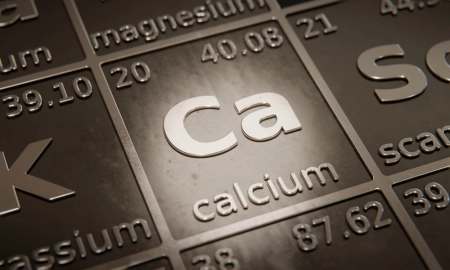
Calcium (Ca) is a very important chemical element in biological processes such as geological phenomena.
This element belongs to Group 2 of the periodic table, known as the alkaline earth metals, and is in period 4. Its importance lies in its essential role in biology, chemistry and industry.
In this article we address the main characteristics of this chemical element: its presence in the periodic table of elements and its physical and chemical properties.
Calcium in the periodic table
Calcium has the symbol Ca and atomic number 20, meaning that its nucleus contains 20 protons. Its electron configuration is [Ar] 4s², indicating that it has two electrons in its outermost shell, which are responsible for its high chemical reactivity.
As part of the alkaline earth metals, it shares common properties with other elements in its group, such as magnesium (Mg) and strontium (Sr).
Calcium is a metal, and although we rarely find it in its elemental form in nature due to its high reactivity, it is widely distributed in the form of compounds, such as calcium carbonate (CaCO₃) and calcium sulfate (CaSO₄).
Physical properties of calcium
Calcium is a silvery or greyish metal, shiny in appearance when freshly cut. However, when exposed to air, it quickly loses its shine due to the formation of a thin layer of calcium oxide on its surface, which protects it from further oxidation.
Some of its most relevant physical properties include:
- Melting point: 842 °C
- Boiling point: 1484 °C
- Density: 1.55 g/cm³ (less dense than other metals such as iron or copper).
- Malleability and ductility: It is relatively malleable, meaning it can be worked into thin sheets, although it is less ductile than other softer metals.
- Conductivity: Calcium is a good conductor of electricity and heat, which is characteristic of metals.
These physical properties make calcium useful in specific industrial applications, such as in metallurgy, where it is used as a reducing agent to extract other metals, such as uranium and thorium.
Chemical properties of calcium
Calcium is a chemically active element. Because of its two electrons in the outermost shell (s-shell), it tends to lose these electrons easily, forming the Ca²⁺ ion , which is highly stable. Below we describe some of its most notable chemical properties:
Reactivity with oxygen
 Calcium reacts rapidly with oxygen in the air to form calcium oxide (CaO) , also known as "quicklime."
Calcium reacts rapidly with oxygen in the air to form calcium oxide (CaO) , also known as "quicklime."
This reaction occurs spontaneously, although not as violent as in the case of the Group 1 alkali metals. The reaction can be represented as follows:
2Ca+O₂→2CaO
Reactivity with water
Calcium reacts with water, releasing hydrogen gas and forming calcium hydroxide (Ca(OH)₂) , an alkaline substance:
Ca+2H₂O→Ca(OH)₂+H₂↑
Although this reaction is not as violent as that of the alkali metals, it produces visible bubbles of hydrogen gas, demonstrating its reactive nature.
Reactivity with acids
Calcium reacts vigorously with acids to release hydrogen gas and form salts. For example, with hydrochloric acid (HCl), it produces calcium chloride (CaCl₂):
Ca+2HCl→CaCl₂+H₂↑
Formation of compounds
Calcium forms a variety of important compounds, such as:
- Calcium carbonate (CaCO₃): Main component of calcareous rocks, marble and seashells.
- Calcium sulfate (CaSO₄): Present in plaster.
- Calcium chloride (CaCl₂): Used to de-ice roads.
These compounds are crucial in both industrial processes and in nature.